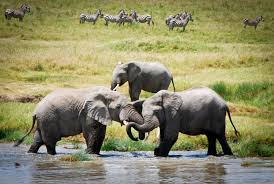The elephant population in Tanzania has increased from 43,330 in 2014 to over 60,000 this year. The government attributes the increase to crackdown on poaching syndicates.
A key figure in the poaching and black market trade of ivory, was arrested denting the industry greatly. Christened, the “Ivory Queen” Yang Fenglan, a prominent Chinese businesswoman was last year sentenced to at least 15 years in prison.
However, by time of her arrest, it is estimated she alone was responsible for the smuggling numerous tones of ivory to China. Yang was tried and found guilty of operating one of Africa’s biggest ivory-smuggling rings. By the of her arrest, she is said to have been responsible for smuggling ivory worth over USD2.5m. That value is estimated to have been derived from the slaughter of almost 400 elephants.
Following her arrest, activists suffered a great lose with the murder of Roger Gower in 2016. Gower, an activist and British helicopter pilot was gunned down in Maswa Game Reserve as he tracked poachers.
Thanks to such activists and special units that cracked down on the organized crime rings, the number of endangered species is increasing.
ALSO READ: Tanzania’s Tourism Board unveils luxury route to scale Mount Kilimanjaro
However, while the trend is good, there is still a long way to go to reach the 110,000 population of 2009. None the less, the country is clearly moving in the right direction.
There is similar progress in the number of rhinos which have now been listed as endangered species. In 2014, the government census placed the number of rhinos as low as only 15 rhinos in the wild. But over the course of the last 5 years, that number has more than quadrupled to at least 167.
It is largely believed that demand for ivory across Asian countries such as China fuels the poaching rings in Africa. Asians use the ivory for various purposes ranging from prestigious ornaments to aphrodisiacs.
This demand makes fighting poaching very difficult because the poachers on the ground are actually from impoverished societies. So the temptation to make some side money is great.
Understanding this delicate balance has helped fight poaching by providing alternative sources of revenue to societies on the vicinity of national parks and game reserves
Tanzania has set aside 32 percent of its total land area for conservation and has several world renowned heritage sites. For example, the Selous Game Reserve, a UNESCO World Heritage Site has been center of much discrepancy.
The government wants to place USD3 billion hydropower dam in the site while environmentalists are fighting the move as destructive.
Tanzania relies heavily on tourism which brought to the country some USD2.5 billion last year. This is a great increase that occurred in the span of just 5 years. The revenue was only USD1.9 billion in 2015 and this increase in revenue is credited to the fifth government’s efforts to promote tourism.
ALSO READ: Tanzania’s measures to protect its tourism industry in wake of pandemic
Taking Action, ending poaching
Tanzania teamed up with members of the United States Army’s 43rd Civil Affairs Battalion, a component of Combined Joint Task Force that operates in the Horn of Africa. The US also provided support from its North Carolina National Guard, who helped to conduct anti-poaching training in 2016. Through this partnership, rangers were trained on modern techniques to combat poaching.
Tanzania also partnered with non-profit organisations such as the Grumeti Fund (GF) whose mission is to contribute to the conservation of the ecosystem. Working with GF, Tanzania removed almost 1 500 snares that would otherwise be used by poachers to trap wildlife, including elephants and rhinos.
The government also created special task forces that worked on the grass-root level to infiltrate the poaching rings. Through information collected by the special task forces, the government was able to apprehend a considerable number of poachers.
Working with communities to manage human-wildlife conflict is critical, not only for the success of our day-to-day activities, but for the future of people and wildlife. With an increase in both human and wildlife populations comes more strained interactions and the pressure on organisations such as ours to find solutions for this impending crisis mounts.
With the Covid-19 having almost devastated Tanzania’s tourism sector, an increase in the number of elephant breathes hope of recovery. Elephants are one of the country’s major tourist attractions.
The more elephants there are the more tourists will visit the country. It is now more important than ever before that Tanzania rids its national parks and game reserves of poaching. It is also imperative to provide education to societies that live alongside these game reserves the importance of wildlife.
Education alone is not enough though, with evidence showing that when these communities have alternative sources of revenue then they are less inclined to engage in poaching then Tanzania must invest in the economic stability of these communities.
There is also the need to fight the illegal trade of ivory from the demand side. This means lobbying for the complete ban in the trade of ivory for any purposes whatsoever. By killing the market for ivory, Tanzania can keep more elephants and rhinos alive.
